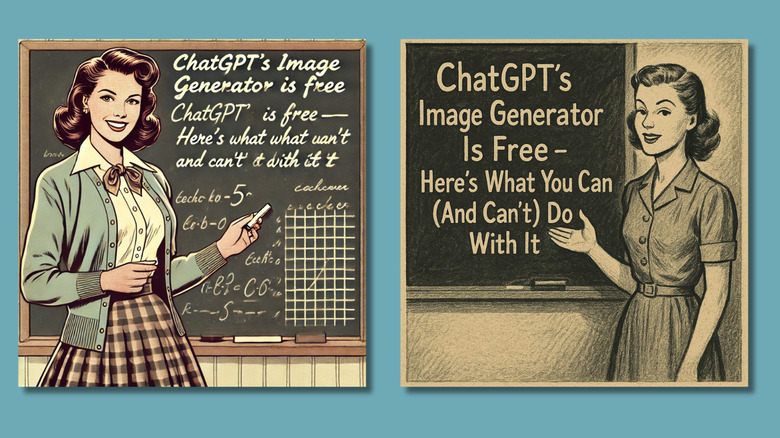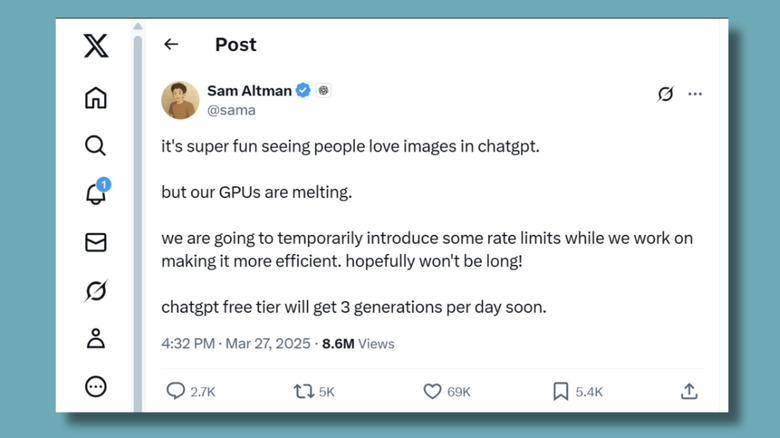ChatGPT's Image Generator Is Free - Here's What You Can (And Can't) Do With It
On April 1, Sam Altman announced on X that ChatGPT's new image generator will now be accessible to free users. It was no April Fool's prank; the image generator, which was launched on March 25 for paid users and sucked hundreds of millions of users into a Ghibli-inspired AI image frenzy that melted OpenAI's servers, is now available to everybody. The downside is that if you don't have a paid OpenAI plan, you're limited to only three image generations a day.
The initial launch at the end of March was fairly quiet, but OpenAI has always had big plans. After all, the 'o' in ChatGPT 4o stands for 'omni,' the Latin word for 'every.' It could originally handle text, speech, and video, and now 4o can add image generation to its capabilities. If you haven't had the chance to use ChatGPT's image generation yet (and you are not as horrified by the existence of AI art as Studio Ghibli's Hayao Miyazaki was in 2016), you might want to give it a go. Although be warned, while many of the early outage issues have been resolved, the model is still having slowness and capacity issues, as everyone, it seems, is hard at work turning their pet pictures into Ponyo homages. Or, in my case, getting AI to create a collection of SlashGear-related images in the style of a children's book.
How is ChatGPT different from other image generators?
So why was this new release such big news? There are already plenty of other AI image generators on the market. The list includes OpenAI's own DALL-E, which hasn't yet been switched off but is now being referred to as its "legacy image generation model."
In a nutshell, ChatGPT's new image generator is really, really impressive. OpenAI has taken massive strides towards making AI art that doesn't look like AI art. Significantly, it can handle incorporating text into images, which is something that AI image generators have previously struggled with. It feels obvious in retrospect that text was going to be the next big step in AI art generation. ChatGPT has always been good with words; it just needed to marry those capabilities with image generation.
Now, you can use ChatGPT to make storyboards, comics, and infographics. You can give it some text and ask it to incorporate it into a prompted image, like the picture on the right above. All the words are there, they're spelled correctly, and contain real letters from the alphabet! I gave the same prompt to DALL-E to produce the image on the left, and while it understood the assignment, it couldn't quite manage to get the words right.
It also has improved character consistency, so it can refer back to pictures it has previously created and draw them in different styles and situations, and it has a neat new transparency feature for creating PNGs you can turn into stickers. And it's still being developed. Sam Altman tweeted on April 2, "Y'all are not ready for images v2..."
What are its limitations?
The only limitation of the free version compared to the paid one is the number of images you can produce per day. The biggest annoyance at the moment for both the free and paid versions is how slow it is. When I tested it, it took about three minutes to produce each image, and that's if it works at all. There have been numerous outages, and OpenAI temporarily put limits on users' requests because, as Altman said, "our GPUs are melting."
Even when it's all running smoothly, creating images in ChatGPT is more time-consuming than the feature-rich dashboards of other image generators like Midjourney or Leonardo. Those models also allow you to create multiple images at a time, whereas ChatGPT limits you to one image per request. There are also no automatic editing options. You need to ask ChatGPT to make changes. While OpenAI boasts about consistency in the new feature, I found that asking it to change and remove things from a previous image while keeping most of it the same is a bit hit-and-miss.
The biggest problem with ChatGPT's image generator, however, isn't its limitations. It's how good it is. Everything we thought we knew about how to spot an AI image, like poorly drawn hands and nonsense text, has gone out the window. It's too soon to say what the long-term effects of this AI advancement are going to be. Will there be even more AI slop saturating social media channels? Are illustrators out of work now? What about the serious environmental implications of AI-generated images? The last few weeks have shown that AI development isn't slowing down, the art is getting better, and it's going to get increasingly difficult to distinguish it from human-created stuff.


